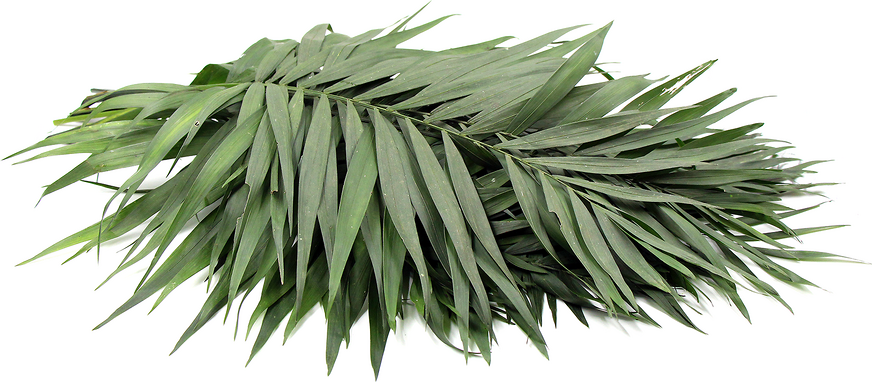


Palm Leaves
Estimated Inventory, bunch : 3.00
This item was last sold on : 08/01/25
Description/Taste
Palm leaves are medium to large in size and elongated and broad in shape. The leaves range in color from deep green to vibrant green and grow in an alternate, palmate, or spiral pattern. Palm leaves are made up of several smaller leaves that can grow in a bunch at the end of the stem or in a feather pattern on all sides of the stem. Palm leaves grow from sheathes that are wrapped around the trunks, and each sheath leaves a distinct band, also known as an excision band, around the trunk as the palm grows. Depending on the variety, the trunk or stem of the palm can be short or extremely tall, smooth or covered in spines, and are capped with a crown of leaves.
Seasons/Availability
Palm leaves are available year-round.
Current Facts
Palm leaves are members of the Arecaceae or Palmae family and grow on flowering evergreen shrubs, trees, and woody vines known as lianas. There are over 2,600 different species, most of which can be found growing in tropical and subtropical climates. While the leaves of the palm are too tough to be edible, palms have been used since ancient times for building materials, paper, and some varieties produce edible fruits that are popularly consumed today such as the coconut, date, and acai berry.
Nutritional Value
Palm leaves are not consumed for nutritional value.
Applications
Palm leaves are not consumed and are most commonly used for decorative purposes. They can be used whole to dress a table or used as a base layer on serving platters. Palm leaves should be trimmed to the desired size and used as a garnish alongside tropical food and drinks. They are commonly used in combination with banana leaves and other local vegetation in the traditional Hawaiian method of cooking using an imu. The Hawaiians used imus, also known as an underground oven, for celebrations to feed large groups of people. Palm leaves were used in the oven to create steam to cook the meat and to protect the meat from scorching.
Ethnic/Cultural Info
Historically, Palm leaves were used as one of the original materials for manuscripts and had been found dating back to the 5th century in parts of Southeast Asia. Palm leaves were also used as construction materials for fences, walls, and roofs. Thick mid ribs were used as support beams, and the leaves were stripped and used to weave baskets, tie rope, and to create mats for sleeping and eating.
Geography/History
Palm leaves have been in existence since the dawn of human civilization with the earliest fossilized record dating back nearly 80 million years to the Cretaceous period. Today they are widely cultivated and grown all over the world and can be found in specialty markets in Asia, Southeast Asia, Africa, Australia, Central and South America, and the United States.
Featured Restaurants
Restaurants currently purchasing this product as an ingredient for their menu.
| The Santaluz Club Inc - Banquet | San Diego CA | 858-759-3150 |
| Fishery - Bar | San Diego CA | 858-272-9985 |
| insideOUT | San Diego CA | 619-888-8623 |
| InterContinental Vistal Kitchen | San Diego CA | 619-501-9400 |
Recipe Ideas
Recipes that include Palm Leaves. One
| Kalai's Cooking Recipes |
|
Palm Leaves Kozhukattai |
| YouTube |
|
Chicken Paturi |




